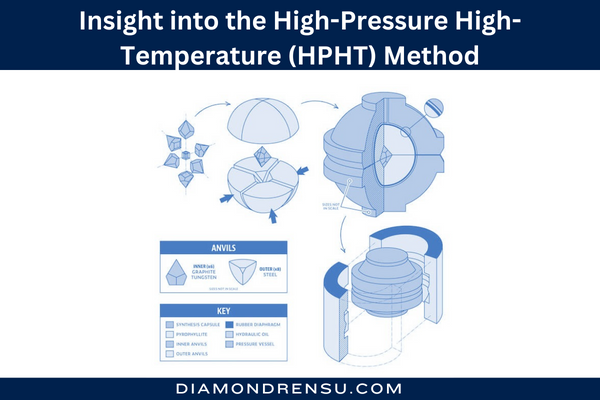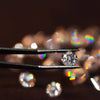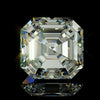
How Big in Size Can Lab Grown Diamonds Get?
Table Of Contents
- Introduction
- Understanding Lab-Grown Diamond Formation
- Explanation of the Chemical Vapor Deposition (CVD) Method
- Insight into the High-Pressure High-Temperature (HPHT) Method
- Factors Influencing the Size and Quality of Lab-Grown Diamonds
- Technological Advancements Pushing the Boundaries
- The Impact of Giant Lab-Grown Diamonds on the Market
- Conclusion
- FAQs: How Big in Size Can Lab Grown Diamonds Get?
Introduction
When it comes to lab-grown diamonds, the possibilities are truly endless. Their popularity has surged in recent years, and for a good reason. These ethically sourced, environmentally friendly gems not only sparkle with brilliance but also come in a wide range of sizes. Whether you're an engagement ring planner, a wedding planner, or simply an enthusiast of anniversary gifts, you might be wondering just how large these lab-grown diamonds can grow. In this guide, we will dive deep into the world of lab-grown diamonds, exploring their formation, methods of production, and the factors that influence their size and quality. So, let's embark on this sparkling journey to uncover the secrets of these mesmerizing gems.
Understanding Lab-Grown Diamond Formation
Before we explore the potential sizes of lab-grown diamonds, it's crucial to understand how they are created. Lab-grown diamonds are cultivated through two primary methods: Chemical Vapor Deposition (CVD) and High-Pressure High-Temperature (HPHT). These methods lay the foundation for the size and quality of the diamonds.
Explanation of the Chemical Vapor Deposition (CVD) Method
The CVD method, short for Chemical Vapor Deposition, is one of the primary techniques for growing lab-grown diamonds. This process involves creating diamonds in a controlled chamber using a carbon-rich gas. Here's how it works:
Gas Precursor Introduction: The CVD process starts with the introduction of a carbon-containing gas precursor, such as methane, into a vacuum chamber. This gas precursor is critical because it provides the necessary carbon atoms for diamond growth.
Activation of Gas: The gas precursor is then activated using a variety of methods, including microwave energy, hot filament, or a combination of both. The activation process breaks down the gas molecules, releasing carbon atoms that will ultimately crystallize into diamond structures.
Diamond Growth: Once the carbon atoms are released, they settle on a diamond seed crystal, which serves as a foundation for the growth. Layer by layer, the carbon atoms accumulate on the seed crystal, forming a larger diamond over time.
Control and Precision: One of the significant advantages of the CVD method is its precision and control over the growth process. Manufacturers can precisely adjust the conditions to influence the diamond's size, quality, and other characteristics.
Purity and Brilliance: CVD diamonds are known for their remarkable purity, with fewer impurities compared to HPHT diamonds. This high level of purity contributes to their brilliance, making them a popular choice for jewelry.
In terms of size, the CVD method allows for flexibility, enabling the production of various diamond sizes. It's worth noting that while CVD diamonds can be grown to be quite large, the process's efficiency often makes it more suitable for growing smaller to medium-sized stones.
Insight into the High-Pressure High-Temperature (HPHT) Method
The High-Pressure High-Temperature (HPHT) method is another prominent technique for growing lab-grown diamonds. This method seeks to replicate the conditions deep within the Earth's mantle, where natural diamonds are formed. Here's how the HPHT process unfolds:
Diamond Seed Introduction: The HPHT process begins with a small natural diamond crystal, known as the seed. This seed crystal will serve as the foundation for the growth of a larger synthetic diamond.
High Pressure and Temperature Environment: The seed crystal is exposed to extreme pressure (typically around 725,000 pounds per square inch) and high temperatures (approximately 1,500 degrees Celsius) in a controlled chamber. These conditions mimic those found deep within the Earth.
Carbon Dissolution and Precipitation: The intense pressure and temperature cause the carbon atoms within the seed crystal to dissolve and then precipitate onto its surface, leading to the growth of a larger diamond.
Slow Cooling: After the diamond has reached the desired size, it is slowly cooled down to room temperature. This gradual cooling helps relieve internal stresses, which can impact the diamond's structural integrity.
Quality and Clarity: HPHT diamonds are celebrated for their high clarity and exceptional structural quality. Their formation under extreme conditions ensures that they have fewer internal flaws and impurities, contributing to their desirability in the world of jewelry.
While HPHT diamonds tend to be smaller in size compared to CVD diamonds, they are renowned for their quality and purity. These characteristics make them ideal for precision tools, industrial applications, and, of course, exquisite jewelry pieces where clarity and brilliance are paramount.
Factors Influencing the Size and Quality of Lab-Grown Diamonds
Several factors play a pivotal role in determining the size and quality of lab-grown diamonds:
Seed Crystal Size: The size of the initial seed crystal can significantly influence the final size of the lab-grown diamond. A larger seed crystal provides the potential for a larger diamond, while a smaller seed crystal leads to a smaller gem. Manufacturers carefully select seed crystals based on the desired outcome.
Growth Time: The duration of the growth process affects the diamond's size. Longer growth periods can result in more extensive diamond crystals. However, it's essential to balance this with the need for high-quality diamonds, as extended growth can sometimes lead to structural imperfections.
Pressure and Temperature: Whether using the CVD or HPHT method, precise control of pressure and temperature is essential to achieve the desired size and quality. These conditions impact the rate of growth and crystal structure.
Gaseous Environment: The composition of the gaseous environment during growth can influence the diamond's characteristics. The ratio of carbon to other gases and the presence of impurities can impact size and quality. Manufacturers meticulously control these environmental factors.
Cutting and Polishing: After the growth process, the diamond undergoes expert cutting and polishing. The skill of the diamond cutter is instrumental in maximizing the size while maintaining the diamond's brilliance and fire. It's a delicate balance that requires expertise.
These factors combined determine the ultimate size and quality of lab-grown diamonds. Whether you desire a large, eye-catching diamond or a smaller, exceptionally clear one, the interplay of these variables allows manufacturers to cater to a wide range of preferences.
Technological Advancements Pushing the Boundaries
Lab-created diamonds, often referred to as lab-grown or synthetic diamonds, have come a long way since their inception. In recent years, significant technological advancements have allowed scientists and gemologists to grow diamonds that were once thought to be beyond the realm of possibility.
Size Matters: Breaking the Limits
When lab-grown diamonds were first introduced, they were typically smaller in size, limited to a few carats. However, today, the size barriers are being shattered. With advancements in High-Pressure High-Temperature (HPHT) and Chemical Vapor Deposition (CVD) processes, lab-grown diamonds have grown to impressive sizes.
These advancements have enabled lab-grown diamonds to reach sizes that can rival even the most famous diamonds mined from the Earth. Imagine dazzling engagement rings or exquisite jewelry pieces adorned with lab-created diamond centerpieces that are several carats in size. This newfound capability has opened up a world of possibilities for jewelers and consumers alike.
Scientific Wizardry: Making It Possible
To understand how lab-grown diamonds can achieve these substantial sizes, it's essential to delve into the science behind their creation. The HPHT and CVD methods involve subjecting carbon atoms to extreme pressure and temperature or a chemical vapor environment, respectively, within a controlled chamber. These conditions encourage the carbon atoms to bond and form the crystal lattice structure that characterizes diamonds.
As technology advances, so does our understanding of how to optimize these processes for larger diamonds. Researchers have fine-tuned the growth parameters to produce larger, high-quality lab-grown diamonds. These diamonds can now exceed the once-imposed size constraints.
Practical Implications
The ability to create larger lab-grown diamonds has practical implications for engagement ring planners, wedding planners, and those seeking exquisite anniversary gifts. Couples can now choose from a wider array of options for their special moments. Whether it's a stunning solitaire engagement ring or a pair of statement earrings, the variety of designs and sizes available is more extensive than ever before.
Furthermore, the affordability of lab-created diamonds is a significant advantage. Larger lab-grown diamonds come at a fraction of the cost of their mined counterparts, allowing for more elaborate and luxurious designs without breaking the bank. This affordability has made lab-created diamond rings and jewelry even more appealing to budget-conscious buyers.
The Impact of Giant Lab-Grown Diamonds on the Market
Now that we've explored the technology that enables the creation of larger lab-grown diamonds, let's turn our attention to how these massive gems are influencing the market.
A Paradigm Shift
The entrance of giant lab-grown diamonds into the jewelry market has brought about a paradigm shift. Traditionally, larger diamonds were primarily associated with mined diamonds, which carried hefty price tags. However, the availability of substantial lab-grown diamonds is changing this perception. As a result, more consumers are opting for lab-created diamonds to enjoy the brilliance and size they desire without compromising their budget.
Ethical and Environmental Appeal
One of the significant driving factors behind the popularity of lab-grown diamonds, including the larger ones, is their ethical and environmental appeal. As consumers become more conscious of the impact of their purchases, the fact that lab-grown diamonds are created without the ethical concerns and environmental consequences associated with diamond mining is a compelling selling point.
Larger lab-grown diamonds have garnered attention not only for their size but also for their ethical and environmental credentials. This makes them an attractive choice for socially and environmentally responsible consumers.
Creative Freedom
For jewelry designers, the availability of larger lab-grown diamonds offers unparalleled creative freedom. They can craft extraordinary and unique pieces that capture the essence of their clients' dreams. Whether it's a remarkable engagement ring, an exquisite necklace, or a pair of statement earrings, the possibilities are virtually endless.
Diverse Applications
Beyond traditional jewelry, larger lab-grown diamonds find applications in various industries, from technology to scientific research. Their exceptional properties make them a valuable asset in cutting-edge technology and scientific experiments, contributing to the growing demand for these diamonds.
Conclusion
In the world of lab-grown diamonds, size is no longer a limiting factor. Thanks to remarkable technological advancements, we can now marvel at the beauty and brilliance of giant lab-grown diamonds. Engagement ring planners, wedding planners, and anniversary gift lovers have a wider array of options to choose from, offering a mix of affordability, ethics, and exceptional beauty.
As the market continues to evolve, these large lab-grown diamonds will undoubtedly play a significant role in reshaping the jewelry industry. So, whether you're planning a special occasion or simply admiring the elegance of these remarkable gems, the future of lab-grown diamonds is shining brilliantly.
In a world where innovation knows no bounds, lab-grown diamonds have proven that the sky's the limit – or should we say, the carats are boundless!
FAQs: How Big in Size Can Lab Grown Diamonds Get?
- What are lab grown diamonds?
Lab grown diamonds, also known as lab created diamonds or lab diamond rings, are gems that are created in a controlled environment with the same physical, chemical, and optical properties as natural diamonds. These gems are becoming increasingly popular due to their ethical and sustainable nature.
- How does the size of lab grown diamonds compare to natural diamonds?
Lab grown diamonds come in a variety of sizes, just like natural diamonds. They can range from small, delicate stones to larger, statement pieces. The size of a lab grown diamond is determined by the growth time and conditions during the creation process.
- What is the largest size available for lab grown diamonds?
Lab grown diamonds can reach impressive sizes, making them perfect for engagement rings, anniversary gifts, or any other special occasion. The largest lab grown diamonds available can be over 10 carats, creating a dazzling centerpiece for your jewelry.
- Are larger lab grown diamonds more expensive?
In general, larger lab grown diamonds tend to be more expensive than smaller ones due to the increased growth time and the higher cost of production. However, they are still considerably more affordable than their natural counterparts, making them an attractive option for those who want a big, beautiful stone without breaking the bank.
- What is the average size for an engagement ring with a lab grown diamond?
The size of a lab grown diamond for an engagement ring varies depending on personal preference and budget. However, a popular choice is a 1-carat lab grown diamond, as it offers a balance between size and affordability. You can always go larger or smaller to suit your taste.
- Can lab grown diamonds be customized to a specific size?
Yes, one of the advantages of lab grown diamonds is the ability to customize the size to your exact specifications. Whether you want a petite stone or a show-stopping centerpiece, lab grown diamonds can be grown to fit your vision.
- How does the size of lab grown diamonds affect their appearance?
The size of a lab grown diamond greatly influences its appearance. Larger diamonds tend to have more sparkle and brilliance due to their increased surface area. However, smaller diamonds can be just as stunning, offering a delicate and understated elegance.
- What is the difference between carat weight and physical size in lab grown diamonds?
Carat weight refers to the diamond's mass and is a standard measurement for diamonds, both natural and lab grown. Physical size, on the other hand, relates to the actual dimensions of the stone. A 1-carat lab grown diamond and a 1-carat natural diamond will have the same carat weight but may differ in physical size due to variations in their cut and proportions.
- Are there any limitations to how big lab grown diamonds can get?
While lab grown diamonds can be grown to impressive sizes, there are limitations based on the growth technology and equipment. These limitations may change over time as technology advances, but currently, the largest lab grown diamonds are typically around 10 carats or slightly larger.
- How do I choose the right size for an engagement ring or special occasion?
Choosing the right size for your lab grown diamond depends on your personal style and budget. Consider the following factors:
Budget: Determine how much you're willing to spend. Larger diamonds generally cost more.
Setting: The style of the ring setting can impact the appearance of the diamond. A bezel setting, for example, can make a smaller diamond appear larger.
Finger size: Consider the size of the wearer's finger. A larger stone may look more proportional on a larger hand.
Personal preference: Ultimately, choose a size that speaks to your heart and makes you or your loved one smile.
- Can lab grown diamonds be set in a bezel setting?
Absolutely! Lab grown diamonds can be set in a variety of settings, including bezel settings. This style is particularly popular for its modern, sleek look and ability to make the diamond appear larger by encircling it with metal.
- Do lab grown diamonds come with certificates to verify their quality and size?
Yes, reputable lab grown diamond suppliers provide certificates from recognized gemological laboratories. These certificates detail the diamond's specifications, including carat weight, cut, color, clarity, and more, ensuring you know exactly what you're getting.
- Are there any downsides to choosing a larger lab grown diamond?
The only potential downside to choosing a larger lab grown diamond is the cost, as larger diamonds are generally more expensive. However, they are still a more affordable option compared to natural diamonds of similar size.
- Can lab grown diamonds be passed off as natural diamonds due to their size?
No, lab grown diamonds are not the same as natural diamonds, and they can be easily distinguished through various gemological tests. Attempting to pass off a lab grown diamond as natural is both unethical and illegal in many places.
- What is the environmental impact of lab grown diamonds, especially larger ones?
Lab grown diamonds have a significantly lower environmental impact compared to natural diamonds. The energy and resources required to create a lab grown diamond are far less, making them a more sustainable choice.
- Are lab grown diamonds as durable as natural diamonds, especially in larger sizes?
Lab grown diamonds share the same durability and hardness as natural diamonds, making them suitable for all types of jewelry, including larger pieces such as engagement rings and statement necklaces.
- Can I upgrade the size of my lab grown diamond in the future?
Yes, many jewelers offer the option to upgrade the size of your lab grown diamond in the future. This can be a wonderful way to celebrate milestones and anniversaries.
- How do I care for and maintain a larger lab grown diamond?
Caring for a larger lab grown diamond is similar to caring for a natural diamond. Keep it clean, store it in a safe place, and have it professionally inspected and cleaned periodically to maintain its brilliance and shine.
- Are there any style trends for larger lab grown diamonds in engagement rings?
Engagement ring styles are ever-evolving, but some trends include using a larger lab grown diamond as the center stone, often with intricate halo settings or bezel settings for added impact and brilliance.
- Can I find unique and custom designs for larger lab grown diamonds?
Absolutely! Many jewelers offer custom design services, allowing you to create a one-of-a-kind piece featuring a larger lab grown diamond. Whether you have a specific design in mind or want to collaborate with a designer, the possibilities are endless.
Leave a comment
Please note, comments must be approved before they are published.











